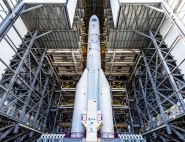CNES projects library
C
I
M
P
S
U
Vega
13 February 2012, Vega made its maiden flight from Europe’s spaceport in Kourou, French Guiana. Since then, the light launcher has conducted two flights on average every year, placing small satellites (from 300 to 2,500 kg) into polar or low-Earth orbit at an extremely competitive price. Vega is thus a valuable addition to the European family of launchers alongside the heavy-lift Ariane 5 and the medium-lift Soyuz. Vega comprises three solid-rocket booster stages topped by a fourth liquid-propulsion stage which has the vital task of releasing the payload and inserting it into the right orbit.
Initiated in 1998 by ESA and ASI, the Italian space agency, the Vega programme today has six partner nations: France, Belgium, Italy, the Netherlands, Sweden and Switzerland. The programme prime contractor is ELV SpA, a joint venture of ASI and Italian firm Avio SpA. CNES oversaw development of Vega’s P80 first-stage engine. Vega is marketed by European launch services provider Arianespace.
